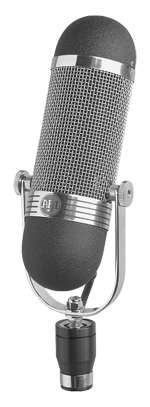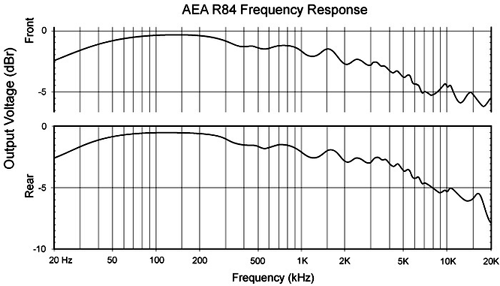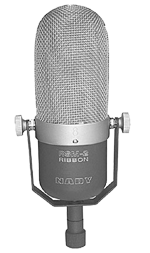by Steve Cunningham
Ribbon microphones are hot again. After falling out of favor in the early sixties with the development of smaller and lighter condenser microphones, new high-tech versions of the ribbon are appearing at various prices. The old RCA 44BX and 77DX ribbon mics probably wouldn’t recognize most of their current progeny, but the past few years have seen a new crop of microphones that combine the smooth character of the ribbon element with modern electronics and manufacturing techniques. Some of these new models have all but eliminated the Achilles’ heel of ribbon microphones, namely the fragile nature of the ribbon element itself.
The latter development may explain why ribbons are hot again. Perhaps it’s just a fashion thing, or maybe it’s because the old RCA ribbon mics (often in questionable condition) still sell for several thousand dollars apiece on eBay and the like. In any case, if what you’re looking for is a retro-sounding VO mic with extended low and high frequency response, a ribbon may be just the thing. Let’s take a look at a few recently-introduced ribbons to see how they stack up.
 AEA R84
AEA R84
Wes Dooley of Audio Engineering Associates has been building re-issue ribbon microphones for years, and repairing vintage ribbons for even longer. His R84 is the most affordable of his re-issue series at a list of $1000, and it bears more than a passing resemblance to an RCA 44BX. Since I didn’t have access to a real RCA ribbon, I borrowed the R84 from the university so I’d have a “reference” ribbon to compare to the others.
The R84 is a classic ribbon in almost every sense. It has a figure-8 polar pattern, although it seemed to me that the back side sounded slightly different (actually a bit more aggressive) than the front side. The microphone’s high end gradually drops about 5 dB from 200Hz up to 20kHz, giving it the typical “mellow” ribbon sound, while its 2-inch long, 2-micron thick aluminum ribbon gives it good transient response. Improving on its ancestor, the specs claim that the R84 will handle better than 165dBSPL above 1 kHz (that’s really loud, people). It comes in a durable and functional foam-lined case and includes an integral shock-mount and 10-foot cable that terminates in an XLR.
I plugged the R84 into a solid-state RNP mic preamp from FMR Audio. This is my go-to mic preamp when I want lots of uncolored gain, and like other standard ribbon mics, the R84’s output is on the low side. I set the preamp for 60 dB of gain, which is about 30 dB higher than needed by a typical condenser mic. This translates into a higher hiss level from the preamp; fortunately you seldom hear it in typical close-mic’ed VO scenarios.

With a male baritone voiceover talent, the R84 performed as I expected it would, delivering a smooth midrange and open high end, with a full-sounding low end that became muddy when the talent got closer than about eight inches from the mic. The mic’s proximity effect is significant, although that actually worked to its advantage with female voice talent.
The R84 is surprisingly directional for a ribbon microphone. Having the talent move his or her head from side to side caused a noticeable change in volume, but not in tone color. This suggests that the mic’s “sweet spot” is large, which is impressive given the R84’s huge size. Considering my experiences with other ribbons where it was difficult to ensure the source signal was hitting the sweet spot at any time, this was a welcome, and positive, change in quality from the rest of the fold.
As with most ribbons, the R84 really beefed up the low end (which makes it useful for thinner female vocals). Though sometimes this caused a bit of mud around 250Hz, this can be fixed with a bit of EQ, generally resulting in a good sound afterward. Still, the R84 is unforgiving where sibilance is concerned — the transient response of the R84 will highlight any esses with male and especially female voicetalent.
 BLUE WOODPECKER
BLUE WOODPECKER
I have a former student who now works for Blue Microphones in Southern California, and he was the one who tipped me that Blue had entered the ribbon mic lottery. Blue has a reputation for making really good mics with really weird names, so I was anxious to check out the $1299 Blue Woodpecker.
Yep, that’s a real wood veneer on the outside of the Woodpecker, framed in gold-plated metalwork. It’s a classy looking microphone, and Blue presents it properly in a cherrywood box that also holds the brass shockmount. The package communicates quality and personality at the same time. In use, this microphone has both.
The Woodpecker features the classic ribbon figure-8 polar pattern, and the specs claim it can handle a max SPL of 136dB, with a dynamic range of 114dB. The frequency response plot is about what you’d expect from a ribbon at 20Hz to 20kHz, with a huge boost below 200Hz but an uncharacteristic 3dB boost around 6 or 7kHz. But what’s very different is that while phantom power can be fatal to some ribbon microphones, this ribbon microphone actually requires 48V phantom to power the active Class A electronics inside the mic body.

For the first go-round, I plugged the Woodpecker into the solid-state RNP. I fully expected to crank the input level to near the maximum for this ribbon. Recording a male VO in his mid-30s who sounded about 20, I was surprised at how little gain was actually required. With the talent about eight inches from the mic, I was able to set the preamp input at 12dB of gain with room to spare and zero noise. His somewhat nasal tone came across with a pleasant fullness in the low end, without any hint of boominess. The highs were clean and open-sounding without any brittleness.
I then plugged the Woodpecker into an all-tube Manley VoxBox. With the same talent, the recording got warmer-sounding, but I again found myself rolling off about 2dB on the low end to keep him from sounding chesty. The highs became smoother but were still clean, and his voice had just the right amount of presence. I switched the Woodpecker with a TLM-103 condenser, and I liked him better on the Woodpecker... he sounded more like he was standing next to me.
On the other hand, with a big-voice-baritone male VO I found it necessary to back him off the Woodpecker another couple of inches to reduce the low end. Any closer than eight inches caused the proximity effect to kick in, which made the baritone too boomy for my tastes. With a female VO, the Woodpecker filled out the low-mids of her voice nicely, and gave me goosebumps on an intimate read. It also tamed her transients and sibilance nicely, as ribbon mics usually do.
The Blue Woodpecker is not your ordinary ribbon microphone. With the Woodpecker, Blue Microphones nailed its first foray into the ribbon category. It definitely has a personality, but it’s one I like. I also like the fact that doesn’t require tons of clean gain to function. While the Woodpecker is not cheap at $1299 (it tends to street at about a grand), it is nevertheless a keeper.
 NADY RSM-2
NADY RSM-2
Can a Chinese-made ribbon mic that sells on the street for under 200 bucks hang with ribbons five times its price? Well, almost...
The Nady RSM-2 carries a list price of $249 and looks to be a copy of the AEA R84, right down to the slight difference in sound quality between the front and back sides. It came to me surrounded by two large pieces of foam, and wrapped in a foot-long padded black bag for protection. Inside was the mic, along with a swivel mount and an attached cable.
The RSM-2 features the classic low-tension 2-inch long, 2-micron thick aluminum ribbon design and produces the expected ribbon sound with smooth lows (although nowhere in the literature could I find a frequency response chart). Its specs claim a very high 165dB SPL capability, its pick-up pattern is the classic figure-8, and its proximity effect is quite pronounced.
How does it sound? Out of the box, it does sound like a ribbon mic, but lacks the open high end and presence of the AEA and Blue ribbons. I lent it to my office mate at the university, and he returned it in a day with a note that said “I can’t imagine where I would use this microphone.” In fact, its muffled high end had me wondering if I’d received a defective unit.
A bit of searching on the Internet came up with an explanation. It seems that to reduce returns due to blown ribbons, the Chinese factory added several layers of wind protection to the element, on the inside of the grille. Several posters suggested that removing two metal wind screens and a silk “bag” that enclosed the ribbon element really opened up the high frequency response of the RSM-2.
At that point I stopped; after all, this was a review unit rather than one I owned, although I’m quite sure that if I did remove the extra wind screens I would end up owning it whether I wanted to or not. As it stands I can’t recommend the Nady mic for critical voiceover work, although I am seriously considering buying one for myself and removing the offending internal bits to see if all those postings on the Internet ring true, so to speak. If I do that, I’ll be sure to keep you posted. In any event, it’s an inexpensive ribbon microphone that does sound like a ribbon microphone, and may sound better given a few, shall we say, modifications.
THE WRAP
Both the AEA and the Woodpecker are clear winners. If you’re in the market for a different sound, or if you’re a female VO looking for a microphone with both guts and character, you should definitely check those two ribbons.
Meanwhile, I might just have to get out the screwdriver after all... the Nady mod is calling...
For more information on the AEA, visit www.wesdooley.com; for more on the Woodpecker, visit www.bluemic.com; and for more information on the Nady RSM-2, visit www.nady.com.
SIDEBAR: HOW A RIBBON MIC WORKS
A ribbon microphone is a variation on the dynamic mic in which a thin, corrugated strip of aluminum is suspended between two poles of a strong magnet. When sound waves hit it, the ribbon moves within the magnetic flux field and a small AC voltage is induced in the ribbon proportional to its movement. The clamps attached to either end of the ribbon double as contact terminals, and wires attached to the clamps carry that signal to a step-up transformer, which raises the output voltage and boosts the output impedance to a usable level for a preamp, typically around 150 to 300 ohms.
Because the ribbon element responds to sound waves arriving from both the front and back but not from the sides, most ribbon mics have a natural bidirectional polar pattern (also known as figure-8). They’re often used to eliminate unwanted noise between two sources, or in pairs to form Blumlein stereo pair arrays. Classic ribbon mics have no internal electronics — just the ribbon, magnets, and transformer. As a result, an older ribbon microphone can require up to 60 dB of clean gain from a mic preamplifier, increasing the noise floor of the mic and preamp combination. Modern ribbon designs include some active electronics to reduce the noise floor, and may require phantom power.
Ribbons have a reputation for fragility, because the ribbon element can be stretched and ruined by exposing it to loud sounds or by simply blowing on it (please don’t do that, okay?). Newer materials and construction techniques have greatly reduced this problem, and modern ribbons can be safely used with loud sources. However, it’s still a good idea to treat a ribbon mic more gently than you would a dynamic or condenser mic. In particular, ribbon mics should be covered when not in use to prevent dust-born metallic particles from sticking to the magnet. In addition, ribbon mics should always be stored vertically to prevent gravity from causing the ribbon to sag and stretch in one direction relative to the magnetic gap.

